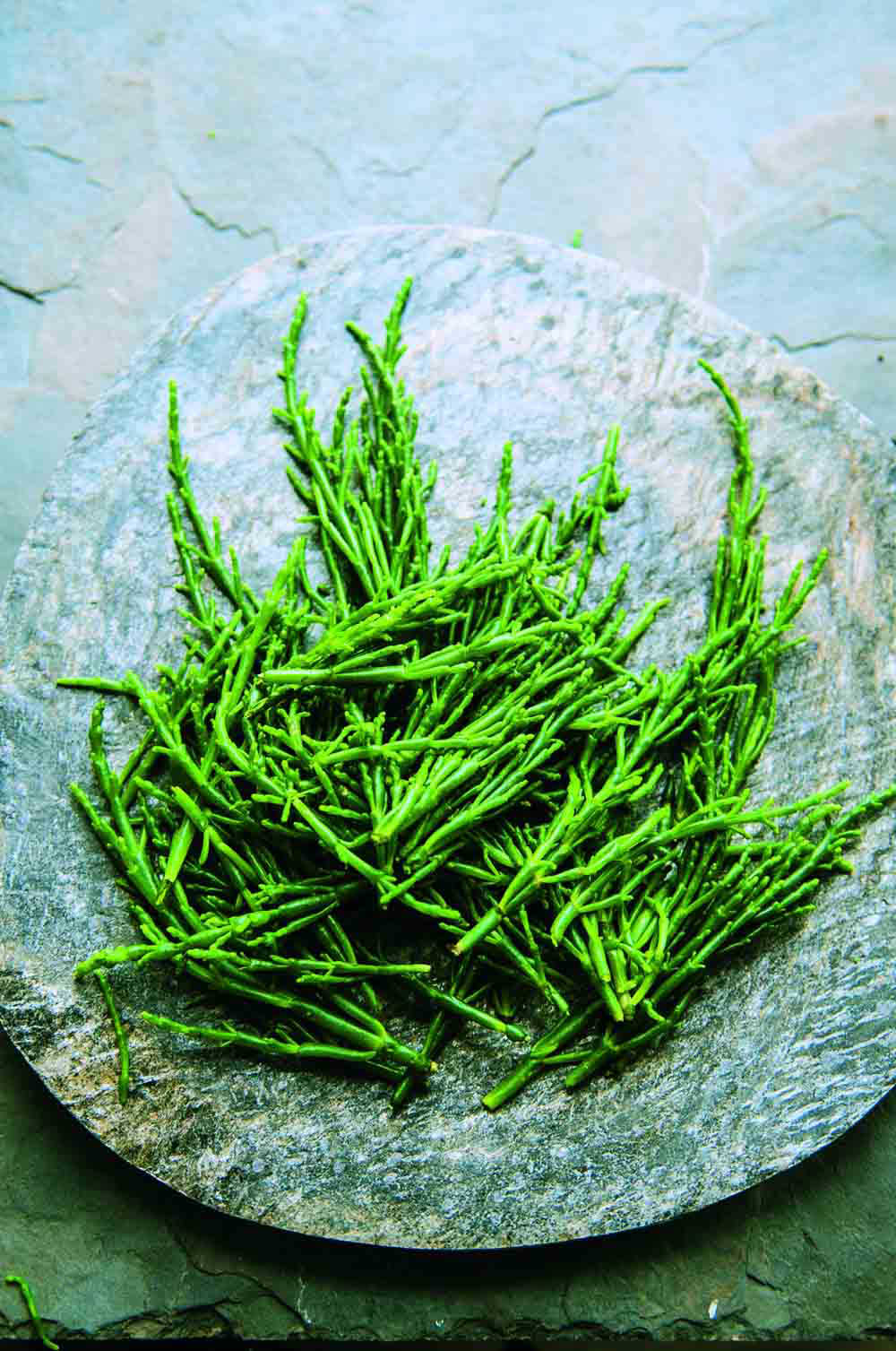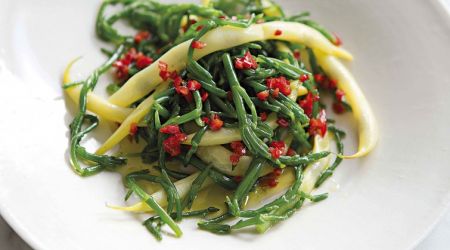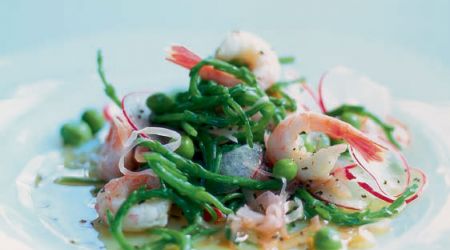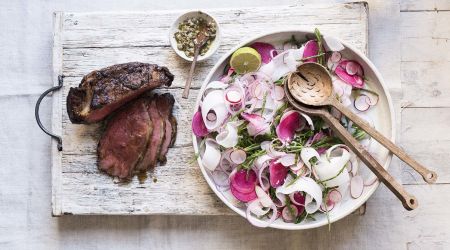Samphire
To shun this salty sea vegetable, says Clarissa Hyman, is to miss out on a tasty and versatile local delicacy. Find out more about the ocean plant, and enjoy our favourite samphire recipes.
‘Once described as the poor man’s asparagus, samphire isn’t just to be valued as a bonus giveaway from the fishmongers, but as a fine food in its own right’
Samphire, as my dear old mother might have said, looks like something the cat dragged in. Even if not actively suspicious about its looks and origins, it is doubtful whether she could have ever allowed a strand of the ragged green branches past her lips. But then she refused till her last breath to eat anything with garlic, and certainly not that dubious foreign concoction sent to undermine the British way of life called ‘pizza’. I doubt she had even heard of samphire (sapphires were a different story) and she was certainly not the sort to go foraging along coastal rocks and cliffs. If it didn’t come tinned, frozen or neatly bagged, then she was not going to risk feeding it to her nearest and dearest.
Like many others, she didn’t know what she was missing. Agreed, it takes a little getting used to, but when you do, the crisp texture and salty edge is the taste of summer by the coast, of bracing sea breezes, hair entangled by spray, waves breaking on the shore… well, you get the picture.
Sea vegetables are gradually becoming more mainstream, trendy even, although it is unlikely samphire will ever be as ubiquitous as garden peas. Once described as the poor man’s asparagus, it is becoming increasingly available from good fishmongers, farmers’ markets and even some supermarkets, valued not just as a bonus giveaway to be ignored until slimy and binned, but as a fine food in its own right.
Marsh samphire is a succulent plant of the salicornia species and not a seaweed, a misconception that perhaps accounts for a certain amount of consumer resistance. It has the advantage, though, of being free – if you are prepared to don your wellies and seek it out around the muddy, sandy flats of estuaries, salt marshes and tidal creeks. It is at its best between June and September. Later than this, and the samphire starts to taste bitter. To gather, search for a stretch of green that looks like a mown lawn. Pinch out or snip off the tops of young plants without pulling out the fibrous stems and uprooting the plant.
Rare rock samphire, also known as sea or true samphire, originated in the Mediterranean, and was eaten by the Greeks and Romans. It is reputed to have a superior flavour – although some describe it as ‘medicinal’ – but is tricky to gather as it is usually found high up on cliffs and rocks. The risky method of foraging is even mentioned in King Lear, with Shakespeare describing it as a ‘dreadful trade’.
Once foraged or bought, wash the samphire thoroughly under running water to get rid of any grit and sand; also remove any remaining roots and tough stems. The fleshy, tubular leaves are filled with a salty juice and make for a satisfying crunch when used fresh or blanched in salads. Alternatively, boil or steam briefly, dip in melted butter (think asparagus) and eat by sucking the leaves off the stalks. It is already quite salty, so there’s no need to add further salt to the cooking water.
Its natural partner is fish, although chef Richard Corrigan suggests a recipe for lambs’ kidneys with samphire on toast, and Nathan Outlaw uses it in a dish of duck, monkfish, rosemary and asparagus, as well as in a mackerel and tomato salad. Food writer Annie Bell came up with the brilliant idea of coating large fronds in batter before deep-frying them as fritters to serve with tomato salsa, something Irish chef Denis Cotter has re-worked with coriander yoghurt.
Samphire pairs beautifully with turbot, plaice, bass, mullet and salmon; in fact, just about any product from the sea. Vegetarians also enthuse: try new potatoes with poached eggs, samphire and broad beans to make the best of the early British summer produce, or a simple purée of samphire and butter.
Some of the best UK samphire is found on the East Coast (Norfolk in particular, where it is frequently pickled in vinegar) and North Wales, along the River Dee marshes. If foraging though, be careful to avoid Sites of Special Scientific Interest, where uprooting plants can result in a hefty fine.
It is possible to grow your own samphire, bought as a pot-grown plant for the windowsill or planted in light, sandy or welldrained soil. Either way it should have a sunny, sheltered position and be well protected from frost. Water it with one teaspoon of sea salt (not table salt) per pint of water. Samphire self-seeds, so will grow every year, although germination may be erratic. In the past it was taken on long sea journeys to prevent scurvy. It was also said to relieve flatulence. Now that’s something my mother would certainly have appreciated.

Recipes
Get Premium access to all the latest content online
Subscribe and view full print editions online... Subscribe












